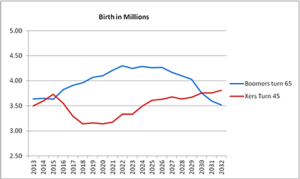According to a recent report from the Federal Reserve Bank, over half (52%) of Americans could not pay for a $400 car repair without borrowing. We can assume that most of these folks would not be legitimate prospects to purchase your business, but what do your qualified prospects actually look like?
I use this space frequently to examine the impact of Boomer retirement, the transition of 60% of the privately held businesses in the US. If you are a regular reader, you’re at least passingly familiar with the demographic, psychographic and sociographic trends that combine to create a seismic shift in the small business landscape between now and 2025.
 (If you are not up to speed on this, download my free EBook collection of blogs, Beating the Boomer Bust. You will be shocked by the numbers.)
(If you are not up to speed on this, download my free EBook collection of blogs, Beating the Boomer Bust. You will be shocked by the numbers.)
Another facet of the challenges facing Boomer business sellers is the lack of liquidity in the buyer population. It can’t be shrugged off as “Those kids just don’t save like we did.” As the Fed survey shows, the problem is deeper and wider than that.
Look at the change in household finances since most Boomers were starting out. The average debt for a newly minted college graduate today is $29,400. They’ve likely had multiple credit cards since they were eighteen. They were raised on a brainwashing media diet of instant gratification. Why should you go without something while you save to buy it, when you can buy it now? You have to budget the money anyway, sacrificing by not enjoying a nice car or big-screen television while you pay for it seems stupid. Personal budgets are built around the ability to make payments.
On the other side of the transaction is a business that has been developed over decades. It has assets and cash flow. Not unreasonably, most Boomer owners expect at least a few hundred thousand dollars for the smallest business, and many are worth millions. How are these already-indebted buyers going to pay for a company when most can’t even muster a substantial down payment?
Yet, most small business owners still say the same things they’ve been saying for the last 20 years. “When I sell my company, I’ll only accept all cash,” or “I will never hold a note for my business.” That simply doesn’t jibe with reality. Buyers will expect financing. It is how they’ve purchased everything in their lives. If they don’t have sufficient net worth to attract a third party lender, the seller is the only remaining source.
The numbers don’t lie. Two-thirds of Boomer owners are 55 or older. The remaining third will reach that age by 2019. One alternative to competing with the throngs of sellers is to transfer your business on what is essentially a “layaway plan.” That method allows your buyer to work in the company while he or she purchases equity in small amounts, eventually building enough ownership to qualify for a third-party loan. It takes time and planning, but so does building a valuable entity in the first place.
Most of those who continue to wait for an individual with the financial resources for an all-cash sale are going to be disappointed.

3 Responses to How Can You Sell a Business to a Buyer Who’s Broke?